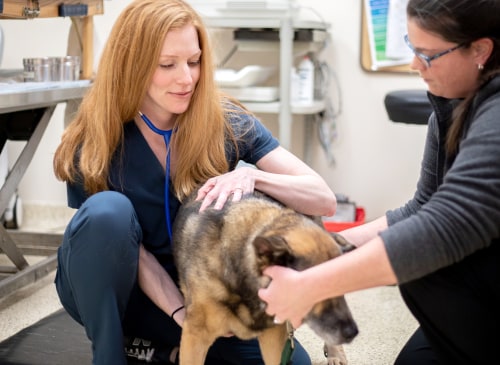The Role of Ultrasound and CT Scan in Modern Veterinary Practices: Insights From Experienced Professionals
In modern veterinary techniques, ultrasound and CT scans significantly improve analysis abilities. These imaging methods supply critical insights right into animal wellness, leading therapy choices. Experienced experts acknowledge the distinct advantages of each modality. Ultrasound supplies real-time analyses, while CT checks provide intricate anatomical details. Comprehending their applications and duties elevates essential questions about their effect on person end results and the future of veterinary diagnostics. What understandings can be obtained from their integrated use?
Understanding Ultrasound in Vet Medicine
Ultrasound is a crucial analysis device in vet medicine, using a non-invasive approach to envision inner frameworks. This imaging strategy uses high-frequency acoustic waves to create real-time pictures of cells and body organs, permitting vets to examine problems without medical treatment. Typical applications include assessing the heart, liver, kidneys, and reproductive organs, along with checking pregnancies.The treatment is fairly quick and can be executed in different settings, making it an easily accessible alternative for veterinarians. Unlike radiography, ultrasound provides comprehensive information concerning soft cells and blood circulation, which is crucial for precise diagnoses.Veterinary specialists depend on ultrasound to find irregularities such as tumors, cysts, and liquid accumulation. Its capability to guide biopsies and various other procedures better boosts its utility in professional method. By supplying a efficient and safe means to analyze inner composition, ultrasound has actually become a keystone of contemporary vet diagnostics.
The Benefits of CT Checks for Animal Diagnostics
CT checks offer substantial benefits in veterinary diagnostics by providing improved accuracy in recognizing inner problems (Ultrasound For Dogs). As a non-invasive imaging method, they ensure the security and convenience of animals throughout exams. Additionally, CT scans assist in a complete assessment of internal structures, enabling more efficient therapy preparation
Enhanced Diagnostic Accuracy
Advancements in imaging technology have substantially boosted diagnostic accuracy in veterinary medicine, particularly with making use of CT scans. These scans give detailed cross-sectional pictures of an animal's interior structures, enabling veterinarians to determine irregularities with accuracy. The high resolution and three-dimensional abilities of CT imaging promote the detection of conditions such as growths, fractures, and internal bleeding that may be missed with conventional imaging techniques. Furthermore, CT scans can aid in pre-surgical preparation by offering a complete sight of physiological connections. This level of information not just enhances the accuracy of medical diagnoses yet additionally help in tailoring effective therapy strategies. As a result, the combination of CT technology right into veterinary practices is changing the landscape of animal healthcare, boosting outcomes for people.
Non-Invasive Imaging Technique
The introduction of non-invasive imaging methods has reinvented animal diagnostics, with CT checks becoming a popular device in veterinary techniques. These scans supply high-resolution, cross-sectional photos of a pet's internal frameworks, allowing veterinarians to evaluate intricate conditions without the demand for invasive procedures. The advantages of CT scans include their ability to identify growths, cracks, and internal blood loss with remarkable precision. In addition, they help with the analysis of soft tissues and body organs, boosting diagnostic abilities. The rate of CT scanning enables fast decision-making, which is important in emergency situation scenarios. By reducing stress and anxiety and discomfort for the animal, CT scans contribute to a more gentle method to diagnostics, eventually boosting therapy end results and progressing vet care.
Comprehensive Internal Evaluation
A comprehensive inner analysis is important for accurate medical diagnosis and reliable therapy in veterinary medication. CT scans offer substantial benefits in this respect, giving thorough cross-sectional pictures of a pet's inner frameworks. This advanced imaging modality enhances visualization of complicated physiological areas, making it possible for veterinarians to recognize irregularities such as lumps, cracks, and interior bleeding with greater accuracy. Additionally, CT scans facilitate the analysis of conditions that might be testing to identify through typical techniques. The speed and precision of CT imaging likewise contribute to prompt treatments, boosting client results. As vet methods increasingly include CT technology, the benefits of substantial inner analyses become apparent, enhancing the relevance of this tool in contemporary veterinary diagnostics.
Comparing Ultrasound and CT Imaging Techniques
While both ultrasound and CT imaging serve essential functions in vet diagnostics, each method uses unique advantages and constraints that can influence medical decision-making. Ultrasound is particularly valued for its real-time imaging capacities, allowing vets to observe vibrant physical procedures. This strategy is non-invasive, mobile, and does not entail ionizing radiation, making it a more secure choice for both medical professionals and animals. Ultrasound might have constraints in picturing certain physiological structures or deep tissues.Conversely, CT imaging gives in-depth cross-sectional views of the body, permitting for exact localization of abnormalities. It masters examining complicated organs and frameworks, especially in the thorax and abdominal area. Nonetheless, CT scans need sedation or anesthesia in lots of situations and entail exposure to ionizing radiation. Inevitably, the choice in between ultrasound and CT depends upon the specific medical circumstance, the location of rate of interest, and the necessity of the analysis requirements.
Situation Studies: Effective Diagnoses Through Imaging
Study show the substantial enhancements in diagnostic accuracy accomplished through sophisticated imaging technologies like ultrasound and CT scans in vet practices. These advancements not only improve the discovery of various problems yet likewise promote reliable and timely therapy plans. Analyzing particular instances can highlight the transformative impact of these imaging methods on vet medicine.
Diagnostic Precision Improvements

Imaging Technology Advancements
As vet imaging technology continues to advance, its effect on analysis capabilities comes to be significantly noticeable. Recent instance studies highlight the effective application of advanced ultrasound and CT check strategies in recognizing intricate problems. For circumstances, a vet facility made use of high-resolution CT scans to detect a rare kind of lung cancer cells in a canine, which traditional imaging had actually missed out on. An ultrasound examination exposed an abdominal mass in a cat, motivating prompt surgical intervention and a favorable result. These advancements not only enhance analysis accuracy yet likewise enable vets to create targeted treatment strategies. By leveraging innovative imaging innovations, veterinary specialists are noticeably enhancing patient treatment, causing much more effective monitoring of numerous health problems in animals.
The Duty of Imaging in Emergency Situation Vet Care
Imaging plays an important duty in emergency veterinary care, offering veterinarians with important info needed to make quick, educated decisions. In immediate scenarios, methods like ultrasound and CT scans make it possible for specialists to promptly evaluate a family pet's inner structures, determining essential conditions such as interior blood loss, fractures, or organ irregularities. These imaging methods allow for real-time assessments, promoting timely interventions that can be life-saving. For example, ultrasound is very useful for assessing soft cells injuries and problems like liquid buildup, while CT checks deal detailed photos of complicated physiological frameworks, crucial for diagnosing trauma situations. The speed and precision of these imaging methods improve the vet's capacity to devise efficient therapy strategies, guaranteeing the very best feasible end results for their patients. The integration of innovative imaging modern technologies into emergency vet methods is not only advantageous but increasingly essential, as it boosts diagnostic abilities and boosts overall animal care during important minutes.

Training and Experience in Vet Imaging
Advanced imaging strategies such as ultrasound and CT scans are vital for reliable veterinary care, the successful execution of these technologies heavily depends on the training and experience of veterinary professionals. Skillful use of imaging tools needs thorough understanding of makeup, pathology, and go to the website the principles underlying each method. Veterinary experts have to click to find out more undergo specific training to precisely interpret imaging outcomes, which is vital for detecting conditions and preparing treatment.Certifications and proceeding education and learning in vet imaging boost the abilities of specialists, enabling them to stay updated with technical advancements. Partnership in between radiologists and vets usually leads to boosted analysis precision, as professionals can give understandings right into complicated situations. Furthermore, sensible experience in taking care of imaging equipment promotes self-confidence in its application. Eventually, the top quality of vet imaging services is directly associated to the degree of training and knowledge had by the specialists using these important analysis tools.
Future Patterns in Diagnostic Imaging for Animals
With the rapid developments in innovation, veterinary analysis imaging is poised for significant evolution in the coming years. Arising patterns indicate a change in the direction of even more portable and accessible imaging techniques, such as portable ultrasound gadgets, which could boost field diagnostics. Additionally, the assimilation of man-made intelligence is anticipated to transform photo analysis, permitting quicker and extra precise interpretations of results.Moreover, innovations in 3D imaging methods and calculated tomography will give veterinarians with even more complete views of pet anatomy, bring about enhanced therapy plans. Digital truth innovation may also play a role in surgical preparation and education and learning, offering veterinarians a distinct perspective on intricate cases.As telemedicine continues to expand, remote appointments assisted in by analysis imaging will certainly become a lot more common, permitting specialists to assist basic specialists in real-time. On the whole, these trends are set to boost the efficiency and efficiency of vet care, eventually enhancing pet results.
Often Asked Questions
Exactly How Much Do Ultrasound and CT Checks Cost in Veterinary Centers?
The costs of ultrasound and CT scans in vet facilities commonly vary from $300 to $1,500, depending upon variables such as place, clinic type, and certain treatments needed for the pet's diagnosis and treatment.

Are There Any Dangers Connected With Ultrasound and CT Checks for Family Pets?
Ultrasound and CT scans typically pose marginal risks to pet dogs. Nevertheless, potential worries include sedation reactions and direct exposure to anesthetics. CT Scans For Dogs. Veterinarians carefully examine each case to alleviate any dangers associated with these analysis procedures
The Length Of Time Do Ultrasound and CT Procedures Typically Take?
Ultrasound procedures normally take around half an hour to an hour, depending on the complexity. CT scans, being even more detailed, normally call for 30 minutes to 90 minutes, consisting of prep work and recovery time for the animal.
Can All Veterinarians Perform Ultrasounds and CT Scans?
Not all vets can perform ultrasounds and CT scans. Specialized training and accreditation are usually needed to ensure expertise in these advanced imaging methods, which might restrict their availability to vets with additional certifications and resources.
What Types of Animals Benefit A Lot Of From These Imaging Techniques?
Particular pet varieties, particularly canines and felines, advantage greatly from ultrasound and CT scans. These imaging techniques enhance diagnostic accuracy for conditions like growths, inner injuries, and body organ abnormalities, bring about improved treatment outcomes and patient care. The high resolution and three-dimensional abilities of CT imaging assist in the discovery of problems such as growths, cracks, and interior bleeding that may be missed out on with typical imaging approaches. Instance researches highlight the considerable renovations in analysis precision attained investigate this site with sophisticated imaging innovations like ultrasound and CT scans in veterinary practices. Improving analysis precision in veterinary practices has actually been substantially helped by improvements in imaging innovations such as ultrasound and CT scans. Sophisticated imaging techniques such as ultrasound and CT scans are important for effective vet treatment, the successful implementation of these technologies greatly depends on the training and know-how of vet specialists. Vet professionals must undertake specific training to accurately analyze imaging results, which is vital for diagnosing problems and preparing treatment.Certifications and continuing education and learning in vet imaging improve the skills of practitioners, allowing them to stay upgraded with technological improvements.